Third quarter 2014 real GDP was revised upward to 3.9% from the original 3.5%. The reason was investment, as changes in private inventories were revised sharply upward. Consumer spending was also stronger by over a quarter of a percentage point and also bumped up the revision. Imports were revised upward and exports downward which subtracted from economic growth. Overall Q3 GDP was surprisingly strong in this Turkey surprise.
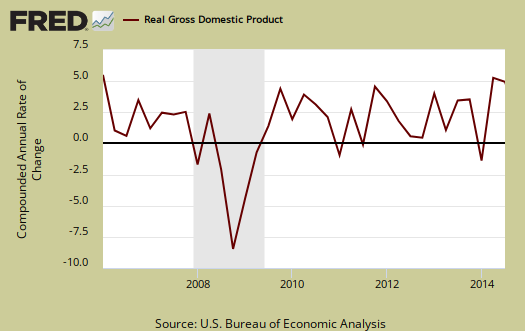
As a reminder, GDP is made up of: where Y=GDP, C=Consumption, I=Investment, G=Government Spending, (X-M)=Net Exports, X=Exports, M=Imports*. GDP in this overview, unless explicitly stated otherwise, refers to real GDP. Real GDP is in chained 2009 dollars.
This below table breaks down the revisions from the advance report and now in Q3 GDP. We expected imports to be revised dramatically up but the changes to private inventories was a bonus boost to Q3 growth which negated increased imports.
| Comparison of Q3 Advance 2014 and Q3 Revision 2014 GDP Components | |||
|---|---|---|---|
|
Component |
Q3 2014 Advance |
Q3 2014 Revision |
Spread |
| GDP | +3.54 | +3.89 | +0.35 |
| C | +1.22 | +1.51 | +0.29 |
| I | +0.17 | +0.85 | +0.68 |
| G | +0.83 | +0.76 | -0.07 |
| X | +1.03 | +0 .65 | -0.38 |
| M | +0.29 | +0.12 | -0.17 |
We now have two quarters of strong GDP growth. This below table shows the percentage point spread breakdown of Q2 from Q3 2014 GDP major components and their spread. Notice how strong exports are, a nice and unusual change.
| Comparison of Q3 2014 and Q2 2014 GDP Components | |||
|---|---|---|---|
|
Component |
Q3 2014 |
Q2 2014 |
Spread |
| GDP | +3.89 | +4.59 | -0.70 |
| C | +1.51 | +1.75 | -0.24 |
| I | +0.85 | +2.87 | -2.02 |
| G | +0.76 | +0.31 | +0.45 |
| X | +0.65 | +1.43 | -0.78 |
| M | +0.12 | –1.77 | +1.89 |
Consumer spending, C in our GDP equation was 39% of GDP. Durable goods were now a 0.63 percentage point GDP contribution, slightly revised upward. Motor vehicles & parts consumer spending added 0.26 percentage points to GDP. In consumer spending services, food & accommodation services was 0.2 percentage points while financial & insurance was 0.28 percentage points, which makes one wonder how jacked consumers are getting on finance charges. Housing and utilities was a -0.23 GDP percentage point contribution which reflects the decreasing energy demand. Below is a percentage change graph in real consumer spending going back to 2000.

Graphed below is PCE with the quarterly annualized percentage change breakdown of durable goods (red or bright red), nondurable goods (blue) versus services (maroon).

Imports and Exports, M & X added 0.78 percentage points to Q3 GDP. Exports were 0.65 percentage points as imports were 0.12 percentage points. This indicates imports were less in Q3 than Q2. Imports are always significantly revised between GDP estimates as more trade data comes into the Census. Regardless this is a strong showing for U.S. exports.
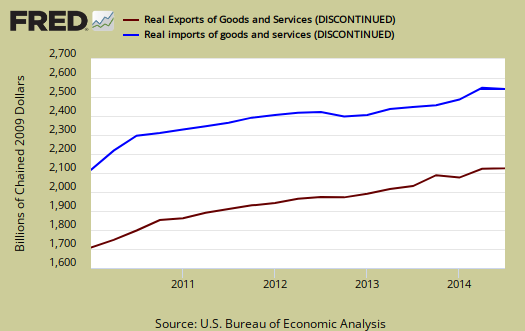
Government spending, G contributed 0.76 percentage points to Q3 GDP, almost all due to national defense spending. National defense spending added 0.66 percentage points to GDP,everything else in government spending is really flat.
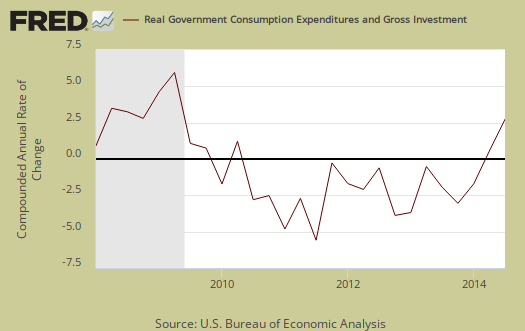
Investment, I is made up of fixed investment and changes to private inventories. Investment contributed only 0 .85 percentage points to Q3 GDP. The change in private inventories alone was revised upward from a -0.57 to a -0.12 Q3 GDP percentage point contribution. Contraction in private inventories should be no surprise after Q2's growth blow out of 1.42 percentage points. Below are the change in real private inventories and the next graph is the change in that value from the previous quarter.
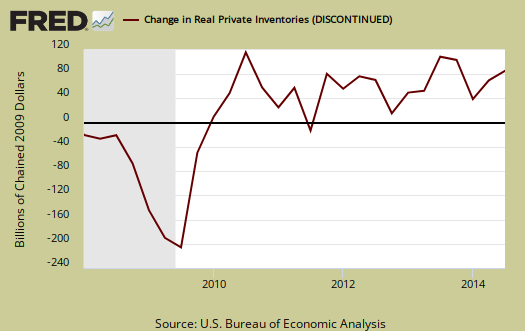

Fixed investment is residential and nonresidential and added 0 .97 percentage points to GDP, revised upward about 0.23 percentage points. Nonresidential was 0.88 percentage points of GDP, with equipment being revised up by 0.2 percentage points to 0.61. Nonresidential structures by themselves was revised downward to only 0.03 percentage points.

Residential fixed investment added only 0.09 percentage points to Q3 GDP. The below graph of residential fixed investment really shows the housing bubble and the lack of economic growth contribution of residential fixed investment to this day.

Nominal GDP: In current dollars, not adjusted for prices, of the U.S. output,was $17,555.2 billion, a 5.3% annualized increase from Q2. In Q2, current dollar GDP increased 6.8%. This shows how inflation and international prices impact real GDP from the wider variance when not adjusted.

Real final sales of domestic product is GDP - inventories change. This figures gives a feel for real demand in the economy. This is because while private inventories represent economic activity, the stuff is sitting on the shelf, it's not demanded or sold. Real final sales increased 4.1%. Q2 real final sales were 3.2%, so in terms of real economic activity it's better.

Gross domestic purchases are what U.S. consumers bought no matter whether it was made in Ohio or China. It's defined as GDP plus imports and minus exports or using our above equation: where P = Real gross domestic purchases. Real gross domestic purchases increased 3.0%. Q2 was 4.8%. Exports are subtracted off because they are not available for purchase by Americans, but imports, as well a know all too well, are available for purchase in the U.S. When gross domestic purchases exceed GDP, that's actually bad news, it means America is buying imports instead of goods made domestically.

GNP - Gross National Product: Real gross national product, GNP, is the goods and services produced by the labor and property supplied by U.S. residents.
GNP = GDP + (Income receipts from the rest of the world) - (Income payments to the rest of the world)
Real GNP increased 3.8% for Q3. In Q2 GNP increased 4.6%. GNP includes, whereas GDP excludes, net income from the rest of the world. GNP increases beyond GDP if Americans made out like bandits from foreign investments more than foreigners cashed in on investments within the U.S. borders.

GDI - Gross Domestic Income: Gross Domestic Income is all income from within the borders of a nation and should normally equal GDP. GDI is wages, profits & taxes minus subsidies. Real GDI was 4.5% in Q3. Q2 GDI was a 4.0% increase. The BEA says GDI measures the economic output as the costs incurred as well as incomes earned in the production of GDP. The BEA also states GDI can have statistical discrepancy over short time periods.
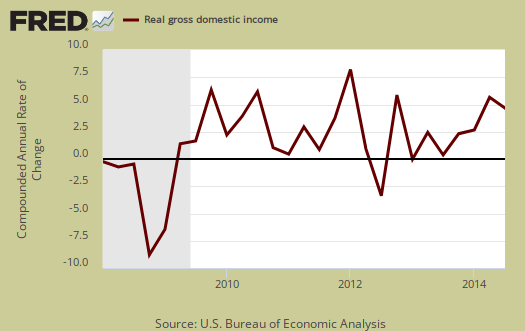
Below are the revised percentage changes of Q3 2014 GDP components, from Q2. There is a difference between percentage change and percentage point change. Point change adds up to the total GDP percentage change and is reported above. The below is the individual quarterly percentage change, against themselves, of each component which makes up overall GDP. Additionally these changes are seasonally adjusted and reported by the BEA in annualized format. National Defense spending alone increased 16% in Q3.
|
Q3 2014 GDP Component Percentage Change (annualized) |
|||
|---|---|---|---|
| Component | Percentage Change from Q2 | ||
| GDP | +3.9% | ||
| C | +2.2% | ||
| I | +5.1% | ||
| G | +4.2% | ||
| X | +4.9% | ||
| M | -0.7% | ||
Other overviews on gross domestic product can be found here,

Recent comments